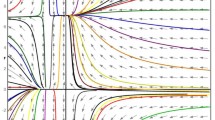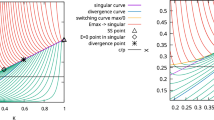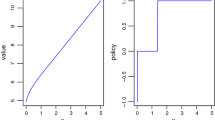Abstract
Models of structured populations consisting of individual species or divided into age groups are considered. One example is fishing for different species that compete for food or habitats. The dynamics of the population in the absence of exploitation is described by a system of differential equations; at certain points in time, part of the resource is extracted from the population. The average time benefit equal to the limit of the average cost of the resource with an unlimited increase in the moments of extraction is estimated. A method of resource extraction for the long-term collection mode is proposed which maintains the constant preservation of a certain part of the population required for its further recovery, and the maximum average time benefit is achieved. The results are illustrated by examples of models of interaction between two species, such as competition and symbiosis.
Similar content being viewed by others
REFERENCES
D. D. Bainov and A. B. Dishliev, “Population dynamics control in regard to minimizing the time necessary for the regeneration of a biomass taken away from the population,” Appl. Math. Comput. 39 (1), 37–48 (1990). https://doi.org/10.1016/0096-3003(90)90120-R
A. I. Abakumov, “Populations optimal harvest (time continuous models),” Mat. Model. 5 (11), 41–52 (1993).
O. L. Zhdanova and E. Ya. Frisman, “The effect of optimal harvesting on the dynamics of size and genetic composition of a two-age population,” Biol. Bull. 41 (2), 176–186 (2014). https://doi.org/10.1134/S1062359013060162
A. I. Abakumov and Yu. G. Izrailsky, “The harvesting effect on a fish population,” Mat. Biol. Bioinf. 11 (2), 191–204 (2016). https://doi.org/10.17537/2016.11.191
G. P. Neverova, A. I. Abakumov, and E.Ya. Frisman, “Dynamic modes of exploited limited population: results of modeling and numerical study,” Mat. Biol. Bioinf. 11 (1), 1–13 (2016). https://doi.org/10.17537/2016.11.1
G. P. Neverova, A. I. Abakumov, and E.Ya. Frisman, “Dynamic modes of limited structured population under age specific harvest,” Mat. Biol. Bioinf. 12 (2), 327–342 (2017). https://doi.org/10.17537/2017.12.327
A. V. Egorova and L. I. Rodina, “On optimal harvesting of renewable resource from the structured population,” Vestn. Udmurt. Univ. Mat. Mekh. Komp. Nauki 29 (4), 501–517 (2019). https://doi.org/10.20537/vm190403
A. O. Belyakov and A. A. Davydov, “Efficiency optimization for the cyclic use of a renewable resource,” Proc. Steklov Inst. Math. 299 (Suppl. 1), S14–S21 (2017). https://doi.org/10.1134/S0081543817090036
A. A. Davydov, “Existence of optimal stationary states of exploited populations with diffusion,” Proc. Steklov Inst. Math. 310, 124–130 (2020). https://doi.org/10.1134/S0081543820050090
F. Jensen, H. Frost, and J. Abildtrup, “Fisheries regulation: A survey of the literature on uncertainty, compliance behavior and asymmetric information,” Mar. Policy 81, 167–178 (2017). https://doi.org/10.1016/j.marpol.2017.03.028
O. A. Kuzenkov and E. A. Ryabova, Mathematical Modeling of Selection Processes (Nizhegorod. Gos. Univ., Nizhny Novgorod, 2007) [in Russian].
L. I. Rodina, “Optimization of average time profit for a probability model of the population subject to a craft,” Vestn. Udmurt. Univ. Mat. Mekh. Komp. Nauki 28 (1), 48–58 (2018). https://doi.org/10.20537/vm180105
G. Yu. Riznichenko, Lectures on Mathematical Models in Biology, Part 1 (Regul. Khaot. Din., Moscow, 2002) [in Russian].
Funding
This study was supported by the Russian Foundation for Basic Research (project no. 20-01-00293).
Author information
Authors and Affiliations
Corresponding authors
Ethics declarations
The authors declare that they have no conflicts of interest.
Additional information
Translated by M. Shmatikov
About this article
Cite this article
Woldeab, M.S., Rodina, L.I. About the Methods of Extracting a Biological Resource That Provide the Maximum Average Time Benefit. Russ Math. 66, 8–18 (2022). https://doi.org/10.3103/S1066369X22010078
Received:
Revised:
Accepted:
Published:
Issue Date:
DOI: https://doi.org/10.3103/S1066369X22010078




